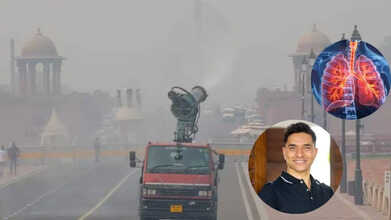- Health Conditions A-Z
- Health & Wellness
- Nutrition
- Fitness
- Health News
- Ayurveda
- Videos
- Medicine A-Z
- Parenting
Why Are Doctors Warning Against Regular Melatonin Use?

Credits: Canva
Melatonin use has increased around the world as people grow more aware of sleep health and seek quick solutions for restless nights. The market now includes both standalone melatonin tablets and mixed formulas combined with calming plant extracts. Many doctors, however, are urging caution, warning that daily use may not be as safe or effective as people assume.
Why Are Doctors Warning Against Daily Melatonin Use?
A few years ago, pediatric sleep specialist Dr Judith Owens began noticing something unusual in her clinic. Owens, who teaches neurology at Harvard Medical School and works at Boston Children’s Hospital, has spent decades treating children who struggle to sleep. What startled her was how many of them were now taking melatonin. She explains that in most cases parents had already tried the supplement before seeking medical help, a sharp change from what she saw earlier in her career.
Also Read: Can High Blood Sugar Lead To Blindness? Expert Explains
As per TIMES, adults have followed a similar path. Between 1999 and 2018, the number of people in the United States using melatonin rose more than fivefold. Because it is sold as a supplement, companies can promote it as a harmless, natural sleep helper without formal review by the U.S. Food and Drug Administration. Yet major sleep groups, including the American Academy of Sleep Medicine, do not recommend melatonin as a treatment for insomnia. Researchers continue to stress that its long-term impact remains uncertain.
How Much Melatonin Is Too Much
As night approaches, the pineal gland begins to release melatonin into the bloodstream. Levels rise through the night and decline after sunrise, helping the body understand the length of darkness and adjust internal functions accordingly.
Researchers have learned that melatonin’s reach extends beyond sleep. It influences immune activity, inflammation, and even the programmed death of cells. As per TIMES, experiments show that several tissues produce small amounts of melatonin on their own, and a wide range of cells carry receptors that respond to it.
Also Read: First U.S. Human Bird Flu Case In Nearly A Year Confirmed In Washington—New Strain Detected
Disturbances in melatonin rhythms have been found in conditions such as depression, bipolar disorder, Type 2 diabetes, schizophrenia, some cancers, and Alzheimer’s disease.
Interestingly, melatonin can be helpful when used under medical direction. Blind individuals with disrupted circadian cycles often benefit from carefully timed doses. Children with autism may sleep better with prescribed melatonin, and scientists have explored whether it could aid recovery after heart attacks.
Melatonin And Heart Failure: Is There A Link?
Despite these potential uses, most people take melatonin in ways that do not match how doctors view the hormone. Since large clinical trials are limited, some researchers have turned to electronic health records to spot trends.
One recent abstract, presented at an American Heart Association meeting, examined adults who were prescribed melatonin and took it for at least a year. These individuals had a markedly higher rate of heart failure compared with similar patients who did not take melatonin. The study sparked attention, though specialists caution against assuming that melatonin caused the problem. Insomnia and heart disease often coexist, so the need for melatonin may simply reflect early signs of heart trouble.
Is Melatonin Bad For You?
Many experts believe that the main issue is the lack of long-term data. Doctors still cannot say whether regular supplementation weakens the body’s own melatonin production. Owens is especially concerned about children who take melatonin nightly for long stretches. Melatonin influences bone growth, immune function, and reproductive development, which raises questions about possible effects later in life.
Some evidence offers reassurance. A Dutch research group followed children with ADHD and other diagnoses who were on medically supervised melatonin for nearly four years. They did not see harmful outcomes. Still, these children were monitored closely and given doses tailored to their needs. Without such oversight, adults and children may easily take more than required, disrupting the body’s internal clock and worsening sleep.
Metabolism also differs from person to person. A dose that is modest for one individual may linger in another’s system well into the morning.
Melatonin Use: Long Term Effects
In the United Kingdom, melatonin can only be obtained with a prescription and is intended for short-term use. Experts say that the ease of buying it over the counter in the United States can lead people to view it as harmless. This mindset often encourages higher or longer-term use.Both Owens and sleep researcher Dr Marie-Pierre St-Onge advise people to focus first on behavioral changes rather than pills. Cognitive behavioral therapy for insomnia, or CBT-I, is considered the most effective treatment for sleep problems in both adults and children. It relies on structured habits and practical adjustments that continue to help long after the treatment period ends.
As Toxic Air Chokes Delhi—Here’s Wellness Expert Luke Coutinho’s Guide To Protect Your Lungs

Credits: Canva
In recent weeks, India’s air quality has taken a steep downturn, with “severe” pollution levels reported in cities such as Delhi, Gurugram, and others. Celebrity nutritionist and holistic wellness expert Luke Coutinho has issued a strong warning about the worsening air, calling it a public health crisis that is already affecting millions.
In a recent Instagram post, Luke admitted he is also struggling to cope with the toxic air—a feeling shared by many of his patients. “Dear citizens, this is more than a health issue; it’s a matter of social justice. Delhi’s air is a serious public health emergency, and parts of Mumbai are in poor to hazardous condition. This is a biological threat,” Luke stated in his post.
Air Pollution And PM2.5
Luke explains that the primary culprit is PM2.5, which are tiny particles can enter the bloodstream, bypassing the body’s natural defenses and causing inflammation. “This isn’t just about coughing. Long-term exposure increases the risk of heart disease, stroke, cancer, chronic lung disease, and even lung and brain damage in children,” he adds.
The good news is that research shows reducing exposure, improving nutrition, and training the lungs can lower inflammation by 20 to 40 percent, according to Luke. He also shares a guide to help families start protecting their lung health.
Luke Coutinho's Guide to Protecting Your Lungs
Here's a detailed guide on how to protect your lungs from toxic air, by Luke CoutinhoFoundation 1: Aggressive Exposure Reduction
To cut down exposure, the first step is to treat indoor spaces as your new outdoor environment. Avoid going out between 10 a.m. and 4 p.m., and check air quality indices like AQLin or SAFAR, especially keeping children indoors if the AQI is above 150. When stepping outside, wear a properly fitted N95 or KN95 mask to ensure 80–95 percent protection, as surgical masks are insufficient.
Indoors, treat air purifiers like essential medical devices. A HEPA purifier in the bedroom can reduce particulate matter by 50 to 70 percent, and it is important to replace filters regularly. Avoid incense, candles, and fireworks, and use a damp mop rather than sweeping to minimize dust.
Lastly, quit smoking entirely, as it compounds the lung damage caused by pollution. Reducing exposure is the single most effective step and can slow lung decline by up to 30 percent.
Foundation 2: An Anti-Inflammatory Nutrition Plan
A diet rich in anti-inflammatory, high-antioxidant foods can reduce pollution-related damage by as much as 35 percent. Include two cups of leafy greens like spinach, kale, and Swiss chard daily, which can be added to smoothies or soups. Add one to two cups of steamed cruciferous vegetables such as broccoli, cabbage, and cauliflower; quick steaming is better than boiling.
Consume two to three servings of antioxidant-rich fruits like guava, apples, and strawberries, with guava highlighted as an excellent source of vitamin C. Include one cup of carotenoids or lycopene from foods like carrots and tomatoes, noting that cooking tomatoes with a little oil improves absorption.
Get omega-3 fats from two to three servings of fatty fish per week or one handful of nuts and seeds daily, such as salmon, walnuts, or flaxseeds, which support heart health. Limit processed sugars, refined carbs, excess salt, and deep-fried foods to under 10 percent of total calories, as they promote inflammation. Stay well-hydrated with two to three liters of water daily to thin mucus and support the lungs’ natural cleansing processes.
Foundation 3: Evidence-Based Supplements
Luke suggests remembering key supplements with the code CODE-Z: C for vitamin C, O for omega-3s, D for vitamin D, E for vitamin E, and Z for zinc. Vitamin C (500–1000 mg/day) from guava and strawberries acts as a powerful antioxidant for the lungs. Omega-3s (EPA/DHA) from salmon or walnuts (1000–2000 mg/day) help reduce inflammation from pollution.
Vitamin D (2000–4000 IU/day), found in cod liver oil and fortified milk, supports immunity and lowers infection risk. Vitamin E (200–400 IU/day) from sunflower seeds and almonds protects lung cells with fat-soluble antioxidants. Supplements are helpful during acute pollution exposure, but food should remain the primary source of nutrients. It is important to take supplements under professional guidance, cycle them every 2.5 months, and consult a doctor before starting any new regimen, especially for children.
Foundation 4: Respiratory Resilience with Breathing Exercises
To strengthen the lungs, practice targeted breathing exercises and maintain humidified air. Pursed-lip breathing involves inhaling for two to four seconds and exhaling for four to six seconds through pursed lips; practicing this for five minutes twice daily can ease breathlessness.
Diaphragmatic breathing strengthens the main breathing muscle, allowing for deeper and more efficient breaths. Additionally, five minutes of steam or humidified air daily keeps airways moist and helps clear mucus, supporting overall respiratory resilience.
But remember, always keep your doctor informed before starting any new supplements or changing your diet, especially for children or if you have an existing health condition. Don’t ignore early warning signs, like persistent cough, fatigue, or shortness of breath, which should be checked promptly. Above all, focus on minimizing your exposure to polluted air first.
Can High Blood Sugar Lead To Blindness? Expert Explains

Diabetes develops when the body can no longer use food efficiently for energy. In this condition, the system either produces too little insulin or does not respond to it well enough. Insulin is the hormone that moves glucose into the cells, where it can be used as fuel. When glucose stays in the bloodstream instead of entering the cells, it begins to harm the blood vessels and nerves that support every organ, including the eyes.
This raises a natural question: can diabetes lead to blindness?
To understand how this happens and what people can do to prevent it, we spoke with Dr Arpan Dev Bhattacharya, Consultant in Diabetes and Endocrinology at Manipal Hospital in Bengaluru.
Also Read: Melatonin Side Effects: Why Doctors Are Warning Against Daily Use?
Can Diabetes Lead To Blindness?
High blood sugar, especially in people living with diabetes, can lead to serious eye problems and even permanent vision loss. When glucose stays elevated for long periods, it harms the fine network of blood vessels that nourish the retina. This injury is known as diabetic retinopathy, a condition that may begin with mild blurring and gradually progress to significant loss of sight if it is not treated in time.
Other eye diseases linked to diabetes include diabetic macular edema, cataracts, and glaucoma, each adding to the risk of visual decline.
Dr Arpan Dev Bhattacharya said, “Earliest changes almost always appear in the retina, the light-sensitive layer at the back of the eye. The vessels here are extremely delicate. When sugar levels remain high, these vessels become fragile or start to leak, creating the groundwork for diabetic retinopathy.”
Also Read: First U.S. Human Bird Flu Case In Nearly A Year Confirmed In Washington—New Strain Detected
Diabetes And Blindness: Early Warning Signs Are Easy to Miss
Diabetic eye disease often begins without noticeable symptoms. Some early clues include blurred or shifting vision, faded colours, difficulty seeing in low light, or small dark floaters that drift across the field of sight. These symptoms can come and go, which makes people dismiss them. Routine eye exams with dilation remain the most reliable way to detect trouble before vision begins to decline.
Blood Sugar Targets That Protect the Eyes
Good metabolic control offers the strongest defence. For most adults with diabetes, the recommended targets include an HbA1c below 7 percent, fasting glucose between 70 and 130 mg per decilitre, and post-meal readings under 180 mg per decilitre. According to Dr Bhattacharya, keeping blood pressure and cholesterol within recommended ranges also helps lower the risk of retinal complications.
Innovative Therapies For Treatment
Researchers are also studying whether certain diabetes medications may offer additional protection. Semaglutide, a GLP-1 receptor agonist widely used for type 2 diabetes and weight management, has drawn particular interest. Dr Bhattacharya said, “Early studies suggest it may reduce stress on retinal cells and slow processes linked to cell injury. Later reviews show that semaglutide does not significantly raise retinopathy risk when compared with other treatments, and some findings even point toward possible benefits. More clinical trials are underway to define its role.”
While new therapies may strengthen prevention strategies, the core advice remains unchanged. Consistent glucose control, regular screening, and timely care provide the best protection against vision loss.
Lone Star Tick: All You Need To Know About The Bite Linked To A Life-Threatening Meat Allergy

Lone Star Tick disease: Scientists have verified the first known death tied to a serious meat allergy brought on by a tick bite. The man, who passed away in 2024 after eating a burger, had alpha-gal syndrome. This condition begins after certain tick bites and leads to dangerous allergic reactions to red meat and other foods made from animals. Two weeks before his death, he had already reacted badly after eating a steak.
“The sad part is that no one recognised that earlier incident as anaphylaxis, so it was never linked to the beef,” said study co-author Thomas Platts-Mills, an allergist at the University of Virginia School of Medicine who helped identify alpha-gal syndrome and diagnosed the New Jersey case, during an interview with NBC News. But how did he develop this condition in the first place?
Also Read: Melatonin Side Effects: Why Doctors Are Warning Against Daily Use?
Lone Star Tick: What Are Lone Star Ticks?
A tick marked with a small white dot is known as the lone star tick (Amblyomma americanum). Many people already know that certain tick species can threaten human health. Lone star ticks are mainly found in Texas and Oklahoma, stretching across the Southern states and moving up the Atlantic coastline to parts of Maine. They live in wooded regions and are most common from April to September.
Falling ill after a lone star tick bite can take several days or even a few weeks. A bite can trigger various problems, including a serious meat allergy known as alpha-gal syndrome.
Also Read: Can High Blood Sugar Lead To Blindness? Expert Explains
Lone Star Tick: What Is Alpha Gal Syndrome?
Bites from lone star ticks can lead to another major effect. The bite can cause the body to develop an allergy to meat. Substances from the tick, including alpha-gal, enter the bloodstream when it bites, which alerts the immune system and prompts the body to create antibodies to the alpha-gal molecule. Humans do not naturally produce this sugar, so the body treats it as foreign.
This reaction can make a person allergic to the sugar. Alpha-gal is present in many common foods, including beef, pork, lamb, dairy products, and gelatin. Once the allergy develops, a person can fall sick after eating these foods.
Experts believe that many people with alpha-gal syndrome have no idea they carry it. In the New Jersey case, it took scientists months to confirm that the man had the syndrome and had died as a result of it. Warmer winters have also allowed ticks to remain active for longer periods, raising the chances of bites throughout the year.
Anyone who thinks they may have this allergy can undergo testing to check. Although there is no cure for alpha-gal syndrome, doctors advise people with the condition to avoid all forms of meat, as well as dairy, gelatin, and some medicines that include these ingredients.
Lone Star Tick: How To Know if You Have the Alpha-Gal Allergy
Many people never realise they were bitten, unless a rash becomes visible. The symptoms of alpha-gal syndrome vary widely and may take weeks to appear, which makes it difficult to diagnose.
Signs of an alpha-gal allergy can include gastrointestinal discomfort after eating foods such as:
- Dairy products, which trouble about 10 to 20 percent of individuals with the allergy
- Red meats like beef, pork, lamb, or venison
- Foods and items that contain gelatin
Other signs may involve hives or, in severe situations, anaphylaxis. The allergy can take four to six weeks to form after the tick bite. Reactions may also be delayed for several hours after a person eats the food that triggers it.
A healthcare professional can test for the alpha-gal IgE antibody through a blood sample. Food challenge tests may also be carried out under medical supervision, in case a severe reaction occurs.
© 2024 Bennett, Coleman & Company Limited

